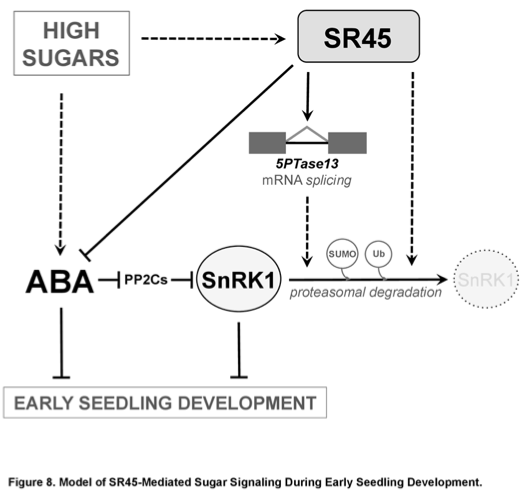Arabidopsis Research Roundup: July 27th
Each of the papers in this Arabidopsis Research Roundup involves the response to different stimuli. Giles Johnson at Manchester provides an audio description of work that has discovered a novel mechanism of cold sensing whilst Gordon Simpson and John Brown from Dundee are contributors to work that has interrogated the sugar signaling pathway. Finally is a study from Warwick that has identified novel loci involved in ABA signaling and seed vigour.
Dyson BC, Miller MA, Feil R, Rattray N, Bowsher C, Goodacre R, Lunn JE, Johnson GN (2016) FUM2, a cytosolic fumarase, is essential for acclimation to low temperature in Arabidopsis thaliana Plant Physiology http://dx.doi.org/10.1104/pp.16.00852
Open Access
Giles Johnson (Manchester) is the corresponding author on this UK-German collaboration that looks at the mechanisms by which plants sense the low temperatures that cause significant phenotypic changes. GC-MS showed that fumarate is a key component in the cold tolerance response and that the activity of the FUM2 enzyme is responsible for accumulation of fumaric acid. Plants that lack FUM2 activity show significant alteration in gene expression and metabolite profile following a cold treatment and in particularly are unable to acclimate photosynthesis at lower temperatures. Therefore this study introduces a novel component of the temperature sensing apparatus, which might have broad significance for attempts to develop crops with an improved cold response.
Giles kindly provides an audio description of this work, which includes an overview into cold acclimation of photosynthesis. This includes an excellent ‘stress-ball’ analogy! (Apologies for pen-clicks :/).
Carvalho RF, Szakonyi D, Simpson CG, Barbosa IC, Brown JW, Baena-González E, Duque P (2016) The Arabidopsis SR45 Splicing Factor, a Negative Regulator of Sugar Signaling, Modulates SNF1-Related Protein Kinase 1 (SnRK1) Stability The Plant Cell http://dx.doi.org/10.1105/tpc.16.00301
Gordon Simpson and John Brown (James Hutton Institute) are contributors to this Portuguese-led study that investigates the role of the SR45 splicing factor in sugar signaling. In sr45-1 mutants they show that glucose-feeding causes increased levels of the energy-sensing SNF1-Related Protein Kinase 1 (SnRK1) yet without increasing its gene expression. Concomitantly the hypersensitivity of sr45-1 mutants is rescued in plants with reduced levels of SnRK1. The authors discovered that the mechanistic link between these genes involves SR45-1 regulating the alternative splicing of the 5PTase13 gene, which encodes an inositol polyphosphate 5-phosphatase that interacts with SnRK1 in vivo. In wildtype plants 5PTase13 modulates proteasomal-mediated degradation of SnRK1 and therefore a perturbation of this process in sr45-1 explains this defect in sugar-sensing.
Morris K, Barker GC, Walley PG, Lynn JR, Finch-Savage WE (2016) Trait to gene analysis reveals that allelic variation in three genes determines seed vigour. New Phytol. http://dx.doi.org/10.1111/nph.14102 Open Access
Bill Finch-Savage is the corresponding author on this study from the Warwick University that uses Brassica oleracea natural variation to identify novel loci involved in seed vigour. The discovered QTL was termed Speed of Germination (SOG1) and contained two genes, BoLCVIG2, a homologue of the alternative-splicing regulator (AtPTB1) and BoLCVIG1, which has unknown function. Transfer of these alleles into Arabdopsis causes alterations in seed germination, which is also observed in mutants of the equivalent Arabidopsis genes (At3g01060, At3g01150). Furthermore an additional discovered QTL encodes the Reduced ABscisic Acid 1 (RABA1) gene, which influences ABA content and seed vigour. Therefore this mapping strategy has discovered three genes that promote seed vigour resulting from alterations in ABA content and sensitivity.
Podcast: Play in new window | Download


Leave a Reply